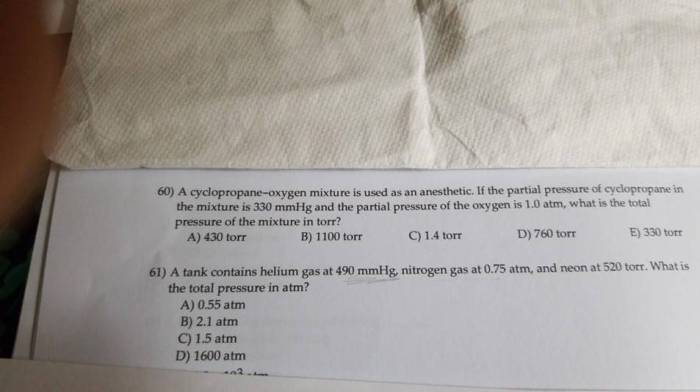A cyclopropane oxygen mixture is used as an anesthetic – A cyclopropane oxygen mixture, a staple in the realm of anesthesia, takes center stage in this discourse. Its unique chemical structure and storied history have shaped its role in modern medical practice. This exploration delves into the advantages and disadvantages of cyclopropane as an anesthetic, shedding light on its administration, monitoring, and potential complications.
By unraveling the intricacies of this remarkable agent, we gain a deeper understanding of its place in the armamentarium of anesthetic options.
Cyclopropane as an Anesthetic Agent

Cyclopropane is a cyclic hydrocarbon with the chemical formula (CH 2) 3. It is a colorless, flammable gas with a slightly pungent odor. Cyclopropane is a potent anesthetic agent that has been used in surgery since the early 1930s.
Chemical Structure and Properties
Cyclopropane is a three-membered ring hydrocarbon. The carbon-carbon bonds in cyclopropane are shorter and stronger than the carbon-carbon bonds in other alkanes. This gives cyclopropane a high degree of ring strain, which makes it a very reactive molecule.
History of Use as an Anesthetic
Cyclopropane was first synthesized in 1881 by August Freund. It was first used as an anesthetic in 1934 by Ralph Waters and Henry Beecher. Cyclopropane quickly became a popular anesthetic agent because of its rapid onset of action, its lack of unpleasant side effects, and its relatively low cost.
Advantages and Disadvantages, A cyclopropane oxygen mixture is used as an anesthetic
- Advantages:Rapid onset of action, lack of unpleasant side effects, relatively low cost.
- Disadvantages:Flammability, risk of explosion, potential for cardiovascular depression.
Oxygen Mixture for Anesthesia

Oxygen is an essential component of anesthesia. It is used to maintain the patient’s oxygen saturation and to prevent hypoxia.
Role of Oxygen in Anesthesia
Oxygen is necessary for cellular respiration. When the body is deprived of oxygen, cells begin to die. This can lead to organ damage and death.
Types of Oxygen Mixtures
There are two main types of oxygen mixtures used in anesthesia: air and oxygen-enriched air.
- Air:Air is a mixture of 21% oxygen and 79% nitrogen.
- Oxygen-enriched air:Oxygen-enriched air is a mixture of more than 21% oxygen and less than 79% nitrogen.
Benefits and Risks
- Benefits:Oxygen mixtures can help to maintain the patient’s oxygen saturation and prevent hypoxia.
- Risks:Oxygen mixtures can increase the risk of fire and explosion.
Administration and Monitoring of Cyclopropane Anesthesia

Cyclopropane anesthesia is typically administered using a closed-circuit anesthesia system. This system consists of a reservoir bag, a vaporizer, and a breathing circuit.
Methods of Administration
There are two main methods of administering cyclopropane anesthesia:
- Inhalation:Cyclopropane can be inhaled through a face mask or an endotracheal tube.
- Injection:Cyclopropane can be injected intravenously.
Monitoring Techniques
During cyclopropane anesthesia, the patient’s vital signs should be monitored closely. These vital signs include:
- Blood pressure
- Heart rate
- Respiratory rate
- Oxygen saturation
Potential Complications
Cyclopropane anesthesia can be associated with a number of potential complications, including:
- Cardiovascular depression
- Respiratory depression
- Nausea and vomiting
- Fire and explosion
Alternatives to Cyclopropane Anesthesia
There are a number of alternative anesthetic agents that can be used instead of cyclopropane. These agents include:
- Isoflurane
- Sevoflurane
- Desflurane
- Nitrous oxide
Advantages and Disadvantages, A cyclopropane oxygen mixture is used as an anesthetic
| Anesthetic Agent | Advantages | Disadvantages |
|---|---|---|
| Isoflurane | Rapid onset of action, lack of unpleasant side effects, relatively low cost | Cardiovascular depression, respiratory depression |
| Sevoflurane | Rapid onset of action, lack of unpleasant side effects, relatively low cost | Expensive |
| Desflurane | Rapid onset of action, lack of unpleasant side effects, relatively low cost | Expensive |
| Nitrous oxide | Rapid onset of action, lack of unpleasant side effects, relatively low cost | Not as potent as other anesthetic agents |
Factors to Consider
When choosing an alternative to cyclopropane anesthesia, the following factors should be considered:
- The patient’s age and health
- The type of surgery being performed
- The anesthesiologist’s experience
- The cost of the anesthetic agent
Popular Questions: A Cyclopropane Oxygen Mixture Is Used As An Anesthetic
What are the advantages of using a cyclopropane oxygen mixture for anesthesia?
Cyclopropane offers rapid induction and recovery, minimal respiratory depression, and reduced nausea and vomiting post-operatively.
What are the disadvantages of using a cyclopropane oxygen mixture for anesthesia?
Cyclopropane is highly flammable and can cause cardiovascular depression, arrhythmias, and seizures.
What are the alternatives to cyclopropane anesthesia?
Alternative anesthetic agents include volatile anesthetics (e.g., sevoflurane, desflurane), intravenous anesthetics (e.g., propofol, etomidate), and regional anesthesia techniques.